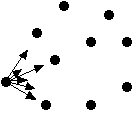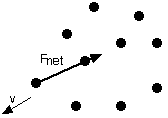(Note that this is the same result you would get from w = mg.)


(Comparing the answers for this question and the last one, notice that the gravitational force that the Sun exerts on the Moon is about 100 times as much as the gravitational force that the Earth exerts on the Moon. Why, then, does the Moon orbit the Earth and not the Sun? )


